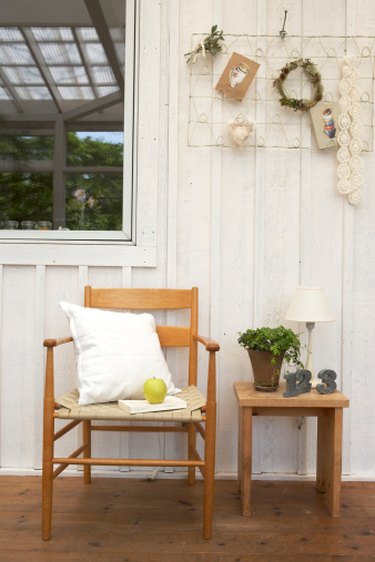Things You'll Need
Sanding sealer
Natural-bristle paintbrush
Sandpaper
Wood stain
Stain applicator pad
Clean rags

Southern yellow pine is a softwood, used in the production of flooring, cabinets and furniture. It features a range of colors, from deep yellow to light gold. Southern yellow pine is readily available, and relatively inexpensive when compared to hardwoods, like walnut, cherry and oak. The wood grain is smooth, knotty and prone to high levels of resin, which may result in streaking when stained. To remedy this problem, you will apply a sanding sealer before you apply the wood stain.
Step 1
Sand southern yellow pine as you would any type of unfinished wood. Before staining, you should sand first with a medium-grit sandpaper, such as 100-grit to remove roughness, followed by a thorough sanding with fine, or 120-grit, sandpaper to fine-tune the wood's surface.
Video of the Day
Step 2
Apply sanding sealer, sometimes sold as "pine sealer" to the surface of the wood with a natural-bristle paintbrush. Follow the instructions on the container, letting the sealer soak into the wood and dry completely.
Step 3
Sand the wood again after the sealer is completely dry. The sealer may slightly raise the grain of the southern yellow pine. Use 220-grit sandpaper and buff the surface of the wood lightly to smooth it.
Step 4
Apply wood stain with a stain applicator pad, smoothing the stain onto the wood liberally, and waiting a few minutes to allow the stain to absorb evenly before wiping with clean rags.
Step 5
Stain an entire board section at one time, if possible. For example, if you're staining a floor, apply the stain to one entire wood plank before wiping it off. If you're staining a cabinet door, apply the wood stain to the entire front section at once, instead of applying a small bit at a time to prevent lap marks on the wood.
Step 6
Repeat the staining and wiping process until you've stained all the wood.
Tip
You can stain southern yellow pine to mimic the color of a darker hardwood, but upon close inspection, the different grain patterns will still be obvious.
Apply a finish coat, such as polyurethane or varnish to protect the wood after staining.
Warning
Do not throw away the wet rags you used to wipe off the stain. Spread them out individually to let them dry, and then dispose of them in an outside trash receptacle. Wadded up wet stain rags can burst into flame without warning.
Video of the Day